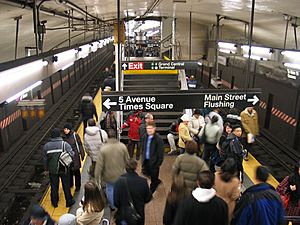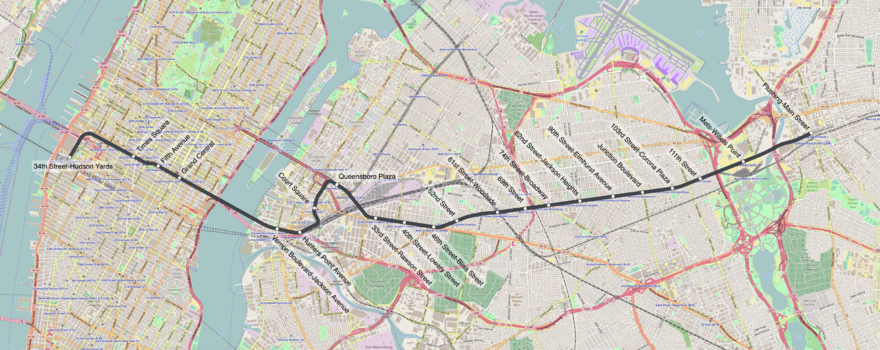IRT Flushing Line facts for kids
Quick facts for kids IRT Flushing Line |
|
|---|---|
 
The 7 and 7 Express, which use the Flushing Line through Midtown Manhattan, are colored purple.
|
|
| Overview | |
| Owner | City of New York |
| Termini | Flushing–Main Street 34th Street–Hudson Yards |
| Stations | 22 |
| Service | |
| Type | Rapid transit |
| System | New York City Subway |
| Operator(s) | New York City Transit Authority |
| Daily ridership | 425,688 |
| History | |
| Opened | 1915–1928 (between Times Square and Flushing–Main Street) September 13, 2015 (between 34th Street and Times Square) |
| Technical | |
| Number of tracks | 2–5 |
| Character | Underground (Manhattan, Western Queens and Main Street) Elevated (east of Hunters Point Avenue and west of Main Street, exclusive) |
| Track gauge | 4 ft 8 1⁄2 in (1,435 mm) |
| Electrification | 625 V DC third rail |
The IRT Flushing Line is a rapid transit route of the New York City Subway system, named for its eastern terminal in Flushing, Queens. It is operated as part of the A Division. The Interborough Rapid Transit Company (IRT), a private operator, had constructed the section of the line from Flushing, Queens, to Times Square, Manhattan between 1915 and 1928. A western extension was opened to Hudson Yards in western Manhattan in 2015, and the line now stretches from Flushing to Chelsea, Manhattan. It carries trains of the 7 local service, as well as the express <7> during rush hours in the peak direction. It is the only currently operational IRT line to serve Queens.
It is shown in the color raspberry on station signs, the official subway map, and internal route maps in R188 cars. Before the line was opened all the way to Flushing in 1928, it was known as the Corona Line or Woodside and Corona Line. Prior to the discontinuation of BMT services in 1949, the portion of the IRT Flushing Line between Times Square and Queensboro Plaza was known as the Queensboro Line. Since the mid-2010s, the line's signal system has been converted to an automated system.
The Flushing Line has various styles of architecture, which range from steel girder elevated structures to European-style concrete viaducts. The underground stations have some unique designs as well. The designs include Hunters Point Avenue, which is in an Italianate style; Grand Central–42nd Street, which is a single round tube similar to a London Underground station; and 34th Street–Hudson Yards, which, with its deep vault and spacious interior, resembles a Washington Metro station.
Contents
Extent and service
Route
Services that use the Flushing Line are colored raspberry. The following services use part or all of the IRT Flushing Line:
| Service | Time period | |
|---|---|---|
| Rush hours, peak direction |
Other times | |
| Full line | ||
| Full line | No service | |
The line has two distinct sections, split by the Queensboro Plaza station. It begins as a three-track subway, with the center track used for express service, at Flushing–Main Street. It quickly leaves the ground onto a steel elevated structure above Roosevelt Avenue, passing Citi Field and the United States Tennis Association's National Tennis Center. A flying junction between Mets–Willets Point and 111th Street provides access to the Corona Yard from the local tracks. At 48th Street in Sunnyside, the line switches to Queens Boulevard and an ornate concrete viaduct begins. The express track ends between 33rd Street–Rawson Street and Queensboro Plaza.
At Queensboro Plaza, the eastbound track (railroad north) is above the westbound track, with both tracks on the south side of the island platforms. On the north side of these platforms is the BMT Astoria Line. East of this point, both the Flushing Line and the Astoria Line were formerly operated by the IRT and the BMT. Connections still exist between the eastbound tracks just east of the platforms, but cannot be used for revenue service as BMT trains are wider than IRT trains. This is the only track connection between the Flushing Line and the rest of the subway system.
West of Queensboro Plaza, the line sharply turns south onto an elevated structure over 23rd Street. It heads into the west end of Amtrak's Sunnyside Yard, and passes through two underground stations before entering Manhattan via the Steinway Tunnel under the East River. In Manhattan, the line runs under 42nd Street, with part directly underneath the 42nd Street Shuttle (S train), before angling towards 41st Street. The Times Square–42nd Street station, with no track connections to other lines, is directly under 41st Street.
West of Times Square, the tracks curve sharply downward before turning under 11th Avenue. The tracks end at 24th Street, even though the last station is at 34th Street. This segment was built as part of the extension of the Flushing Line west to Manhattan's Far West Side (see § Extension westward). A decommissioned lower level at the IND Eighth Avenue Line's 42nd Street–Port Authority Bus Terminal station formerly blocked the way. Although London ultimately received the bid for the 2012 Summer Olympics, New York City pursued the extension anyway, albeit as a means to enable the redevelopment of the far West Side under the Hudson Yards Redevelopment Project.
Distinctions
The Flushing Line is one of only two New York City non-shuttle subway lines that hosts only a single service and does not share operating trackage with any other line or service; the other is the BMT Canarsie Line, carrying the L train. Because of this, the MTA is automating the line with new trains using communication-based train control (CBTC), similar to the Canarsie Line (see § Automation of the line).
The IRT Flushing Line's 7 service has the distinction of running trains with the largest number of cars in the New York City Subway. 7 trains are eleven cars long; most other New York City Subway services run ten or eight-car trains. The trains are not the longest by total length, however. An IND/BMT train of ten 60-foot (18 m)-long cars or eight 75-foot (23 m)-long cars, which is 600 feet (180 m) long, is still 35 feet (11 m) longer than an IRT train of eleven 51.4-foot (15.7 m)-long cars, which is 565 feet (172 m) long.
See also
 In Spanish: Línea Flushing para niños
In Spanish: Línea Flushing para niños




